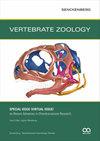Citizen Science, taxonomy and grass snakes: iNaturalist helps to clarify variation of coloration and pattern in Natrix natrix subspecies
IF 2.4
2区 生物学
Q1 ZOOLOGY
引用次数: 11
Abstract
Abstract We used a dataset of georeferenced photos of 5,751 grass snakes from iNaturalist to evaluate subspecific variation of Natrix natrix in coloration and pattern. Our results provide evidence that all four genetically delineated subspecies differ morphologically, although unstriped individuals of N. n. vulgaris are difficult to tell apart from the nominotypical subspecies. The iNaturalist dataset shows that the frequency of dark body coloration increases from south to north and from west to east. This trend is both concordant with taxonomic variation (the easternmost subspecies, N. n. scutata, being the darkest taxon) and variation within the same subspecies (in N. n. natrix and N. n. scutata more northern populations harbor more dark or melanistic individuals than more southern populations). Although available characters were limited to coloration and pattern traits, our study suggests that photo material from iNaturalist and similar platforms can be a valuable data source for studies on morphological variation. However, investigations using such databases can only supplement, but not replace, studies using museum material because only then measureable, meristic and genetic characters will be accessible.Citizen科学,分类学和草蛇:iNaturalist帮助澄清Natrix Natrix亚种的颜色和模式变化
摘要我们使用来自iNaturalist的5751条草蛇的地理参考照片数据集来评估Natrix Natrix在颜色和图案方面的亚种变异。我们的研究结果提供了证据,表明所有四个基因描述的亚种在形态上都不同,尽管普通N.N.vulgaris的未成熟个体很难与命名不典型亚种区分开来。iNaturalist数据集显示,暗体着色的频率从南向北和从西向东增加。这一趋势既与分类学变异一致(最东部的亚种N.N.scutata是最黑暗的分类单元),也与同一亚种内的变异一致(在N.N.natrix和N.N.N.scutta中,更多的北方种群比更多的南方种群拥有更多的深色或黑色素个体)。尽管可用的特征仅限于着色和图案特征,但我们的研究表明,来自iNaturalist和类似平台的照片材料可以成为研究形态变异的有价值的数据来源。然而,使用此类数据库的研究只能补充而不能取代使用博物馆材料的研究,因为只有这样,才能获得可测量的分生组织和遗传特征。
本文章由计算机程序翻译,如有差异,请以英文原文为准。
求助全文
约1分钟内获得全文
求助全文
来源期刊

Vertebrate Zoology
ZOOLOGY-
CiteScore
4.00
自引率
19.00%
发文量
42
审稿时长
>12 weeks
期刊介绍:
Research fields covered by VERTEBRATE ZOOLOGY are taxonomy, morphology, anatomy, phylogeny (molecular and morphology-based), historical biogeography, and palaeontology of vertebrates.
 求助内容:
求助内容: 应助结果提醒方式:
应助结果提醒方式:


